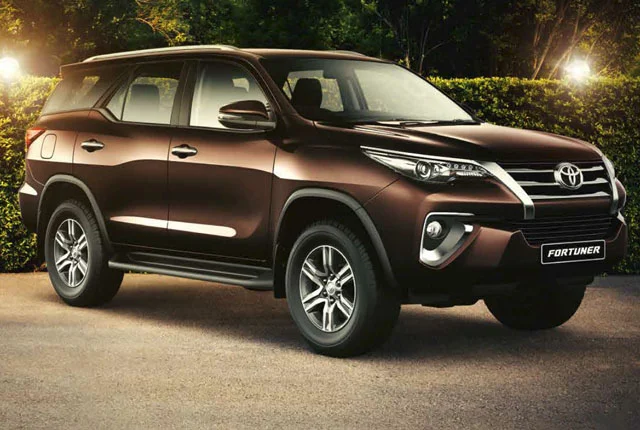
ANDREW MUZAMHINDO THE Toyota Fortuner brand was launched on the Zimbabwean roads almost two decades ago. Buyers who always wanted the durability and reputation of a Hilux but without sacrificing the comfort of a car had something to get excited about. Rivals like Hyundai and Kia also had their SUVs, but they did not have the brand confidence Toyota had established over the years.
The Fortuner has been a revelation for the Toyota brand, fortifying its place as the best-selling SUV in Zimbabwe.
This is one vehicle that I admire because of its solidness and steadiness on the road. Its resale value is unmatched in its category. Every Fortuner is a hit, if not a best seller in its category. It is the best-selling SUV in Zimbabwe and many other countries, but not without its flaws.
A few years ago, the market started to complain about the Fortuner’s lack of comfort, specs, and tech features. So much so that those people ended up trying out competition. The Toyota Fortuner had lagged behind competition.
Ford, at the time, had its Territory, but it could not withstand the finicky buying patterns of our unique market. It was subsequently discontinued from the market and replaced with the Everest.
But the Fortuner, it continued undeterred, registering strong sales figures locally with each passing year.
Fortuner rivals For the last few years, the Fortuner has faced stiff competition from several rivals in Zimbabwe. Yet, no matter how good the marketing pitches and incentivised deals are, the Fortuner never needed to look over its shoulder in fear that it will lose sales. The SUV is, by default, good enough that it basically sells itself.
In Zimbabwe, the Fortuner has three direct rivals — all built on the platforms that underscore the bakkies they are based on. The Ford Ranger-based Everest is powered by a range of diesel engines, with power outputs ranging from 118kW/385Nm to 157kW/500Nm.
- Chamisa under fire over US$120K donation
- Mavhunga puts DeMbare into Chibuku quarterfinals
- Pension funds bet on Cabora Bassa oilfields
- Councils defy govt fire tender directive
Keep Reading
The Isuzu mu-X shares its architecture with the Isuzu D-Max, and only one engine, mated to a six-speed automatic gearbox, is available. The 3.0-litre motor pushes out 130kW/380Nm and is the oldest unit in this company, but a new one is on way.
From Mitsubishi comes the Pajero Sport. The SUV shares its credentials with the Triton double cab bakkie and is powered by a 2.4-litre engine. With 133kW/430Nm to its disposal, the SUV sends its power to its wheels via an eight-speed automatic gearbox. Against its rivals, it is perhaps the most underrated while offering a stellar package at a competitive price.
The top spec flagship 2.8 GD-6 VX 4×4 model, is an ace. From a styling perspective this Fortuner features LED DRL’s upfront with LED fog lights and LED indicators at the bottom of the front bumper.
The rear also benefits from LED tail lights and I particularly like the visually appealing rims. Overall the Fortuner looks good, be it out in the bush or in the urban jungle.
Interior and styling The new Fortuner offers a few updated features which makes ownership and everyday driving better than before. Competition has forced Fortuner to improve internally and externally. On the inside you will find dual-zone climate control on all 2.8 models.
The model that I drove had heated and electric front seats. The VX also gains a Panoramic View Monitor (PVM) with selectable view which makes parking easy as well.
The infotainment system offers Apple CarPlay and Android Auto as well as an impressive 11-speaker JBL Premium Audio system.
The large luggage area handles all sorts with easily. The third row of seats which are mounted to the sides of the luggage area tend to limit space when you need to fully exploit the vehicles load capacity.
The ISOFX mounting points as well as the rear climate control are a huge bonus. You can set the temperature to best suit your kids in the back seats. The legroom is better than in older models.
Performance It is born to perform. The Fortuner rode through potholes of Houghton Park, Waterfalls without much ado. When it rains you do not see these boobytraps called potholes.
The Fortuner is able to handle what a lack of road maintenance can throw at it. As always, the Fortuner’s body-on-frame IMV platform (with double-wishbone suspension up front and a four-link setup at the rear, all coil-springs) gives it the uncanny ability to simply float over gravel and dirt roads while staying exceptionally stable and focused. The Fortuner offers a stress-free driving experience.
With a power plant that delivers 150kW and 500Nm, the 2.8-litre turbo diesel motor provides the grunt that you need. Its tyres, as mentioned earlier, dealt with the potholes of which there were many.
The active cruise control and blind-spot assist can see beyond what you can due to poor visibility caused by the heavy rains we have been experiencing this past week in some parts of Harare.
Safety Toyota’s updated Fortuner (VX trim only) is fitted with Toyota’s Safety Sense package. This is the first time that semi-autonomous driving tech can be found in the Fortuner and plays a huge part in preventing driver fatigue.
Comprising adaptive cruise control, lane departure alert, pre-collision intervention and road-sign recognition, Safety Sense reduces the amount of driver effort required, allowing Dad or Mom to have more patience behind the wheel, and to be less prone to road rage.
The system itself is user-friendly enough, and just sitting back to let the cameras and radar do their thing while all you do is a bit of steering, is a rather luxurious way to travel.
With regards to other safety features, the Fortuner’s equipment includes 7 airbags, stability and traction control, ABS, EBD, hill-start assist, hill- descent control, fog lamps, PDC (front and back) and a rearview camera. Sat-nav is integrated.
Toyota has also added extra convenience and safety which is always a good thing. All Fortuner models now feature a Smart Entry system with additional security measures.
The powered rear tailgate is a benefit. In addition, the VX variant receives additional functionality to the Toyota Safety Sense (TSS) system in the form of Blind-Spot Monitoring (BSM) and Rear Cross Traffic Alert (RCTA). Lane-keep assist and active cruise control also came in handy when we hit the long road for the holiday.
The entry-level derivatives are now better equipped than ever, and driving comfort (especially off-road) is exemplary on all Fortuners.
Verdict Be that as it may, the Fortuner is getting considerably more sophisticated with each refresh as it plays catch up to competition with better interior and tech.
The question going forward for Toyota is will they keep making improvements on the Fortuner whilst decreasing or maintaining the price to levels that can at least fight off competition.
Getting that equilibrium to price point and brand equity for Toyota will prove difficult in future as they face cheaper well-manicured brands that come with respectable performing capabilities especially from China.
Specifications Fuel Economy: 7.6 km per litre Engine Displacement (cc): 2755 No. of cylinder: 4 Max Power (kW@rpm): 150kW@3000-3400rpm Max Torque (Nm@rpm): 500Nm@1600-2800rpm Seating Capacity: 7 Transmission Type: 6 SP electronic automatic Fuel Tank Capacity: 80.0 litres diesel Average Range: 1013km [email protected].










